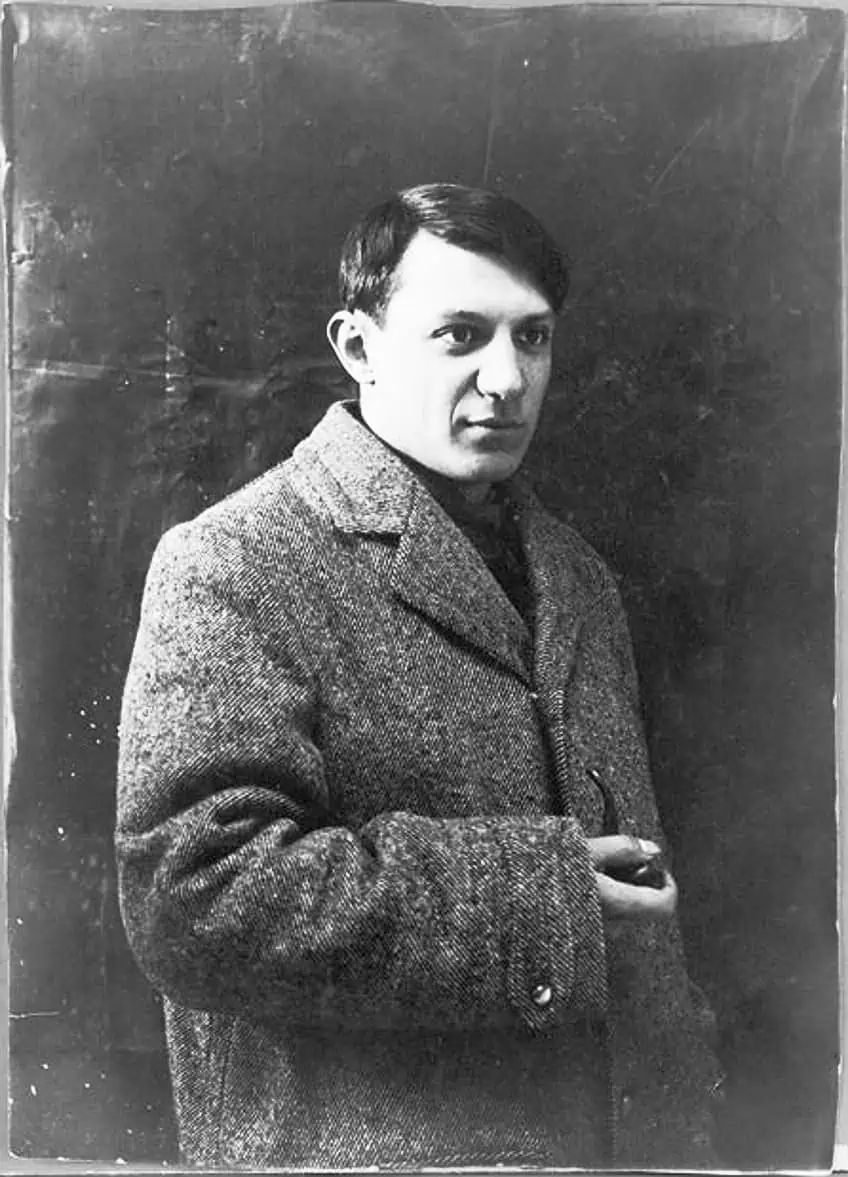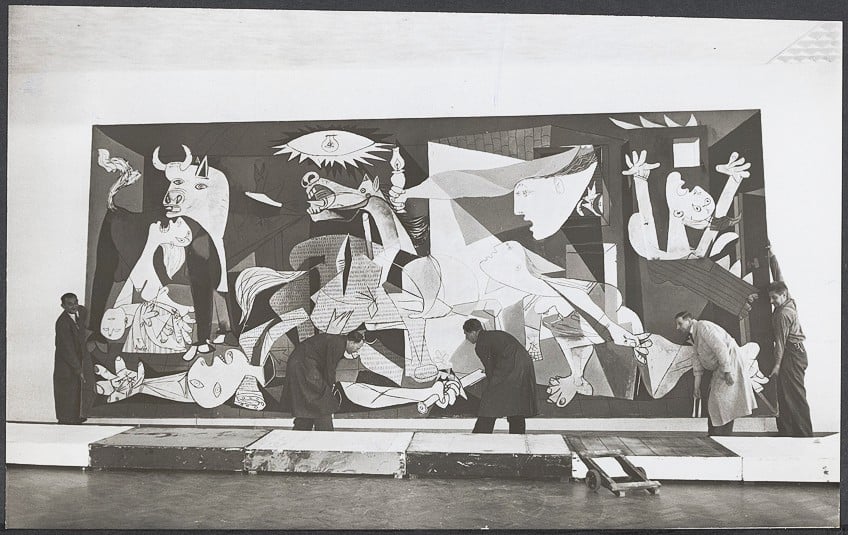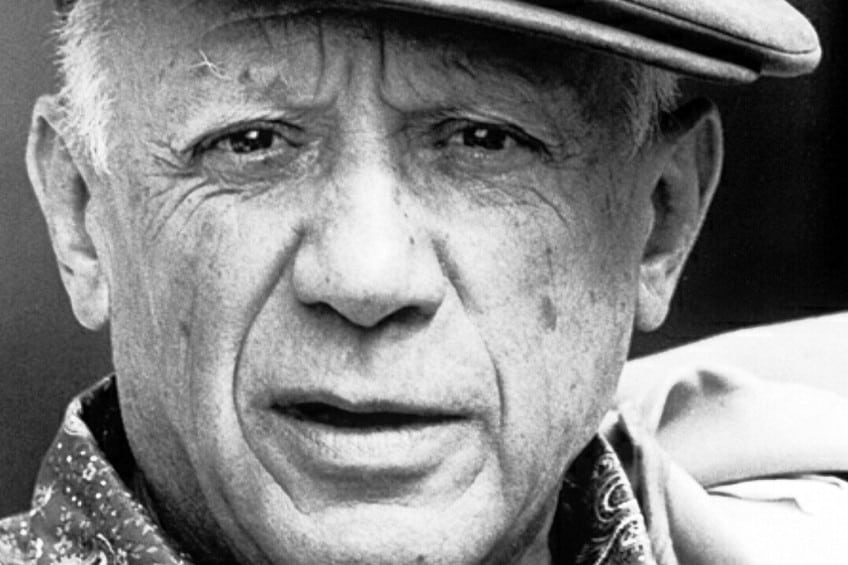“The Weeping Woman” by Pablo Picasso – Famous Abstract Art
The Weeping Woman by Pablo Picasso is a powerful and emotive painting that has become a famous abstract art piece. In this article, we will look at the context within which Picasso created The Weeping Woman painting. We will do a visual analysis of this crying woman painting, touching on composition, subject matter, painting techniques, and so on. We will conclude the article with a section that looks at the reception and implications the Weeping Woman painting had on the art world after its creation.
Artist Abstract: Who Was Pablo Picasso?
Pablo Picasso was born in 1881 in Málaga, Spain. He was the first child of José Ruiz Blasco, a painter, and María Picasso López. At the age of 14, Picasso began studying art at the Academy of Arts in Barcelona. In 1900, he moved to Paris, where he was introduced to the world of modern art. Picasso’s early artworks were influenced by the Post-Impressionist style of Paul Cézanne.
In 1906, he created one of his first major works, Les Demoiselles d’Avignon, which depicted five women in a brothel. This painting marked the beginning of Picasso’s exploration of Cubism, a movement he would help to develop in the coming years.

In the 1910s and 1920s, Picasso continued to develop his Cubist style, creating some of his most famous paintings, including Guernica (1937) and Girl Before a Mirror (1932). In addition to Cubism, Picasso also worked in the styles of Surrealism and Neo-Classicism. Picasso’s influence on art history cannot be overstated. He was a revolutionary artist who challenged the traditional rules of art and paved the way for new movements and styles.
In addition to Cubism, Picasso’s work also had a profound impact on the development of Surrealism.
Throughout his long and productive career, Picasso created thousands of artworks, including paintings, sculptures, prints, and drawings. He is widely considered to be one of the greatest artists of the 20th century, and his legacy continues to inspire artists around the world. He passed away on 8 April 1973 in Mougins, France.
The Weeping Woman (1937) by Pablo Picasso in Context
| Date | 1937 |
| Medium | Oil on canvas |
| Type of Painting | Figure; portrait |
| Movement | Cubism |
| Dimensions (cm) | 60 x 49 |
| Location | Tate Gallery, London, United Kingdom |
The Weeping Woman is a painting by Pablo Picasso that was created in 1937. The painting is a prime example of Picasso’s Cubist style, with the woman’s features fragmented and rearranged in geometric shapes. Before we move on to look at the technical choices Pablo Picasso made when he created this work, we will look at the socio-political context within which he created this painting. We will also contextualize the painting within Picasso’s career.
The Weeping Woman in the Context of Picasso’s Career
The Weeping Woman by Pablo Picasso was created during a significant period in the artist’s career. At the time, Picasso was living and working in Paris, where he had been for over three decades. He was in his mid-50s and was already well-known as one of the most important artists of the 20th century.
In the early 1930s, Picasso had begun to experiment with the style of Cubism, which he would go on to develop and refine over the next few years.
In addition to his Cubist paintings, Picasso continued to work in a variety of other styles throughout the 1930s. In 1935, he created a series of etchings inspired by the myth of Oedipus, and in 1936 he began a series of paintings based on the works of the Old Masters. In 1939, he painted The Dream, which is considered to be one of his greatest surrealist works.
The Weeping Woman in the Context of Picasso’s Personal Life
Picasso’s personal life was also eventful during this period. In 1936, he separated from his wife Olga Khokhlova, and began a relationship with a young French woman named Marie-Thérèse Walter. In 1937, Picasso’s father died, and the following year his mother passed away as well. Despite these personal challenges, Picasso continued to work at a prodigious pace, creating hundreds of artworks during this period.
A Socio-Political Overview of The Weeping Woman Painting
This crying woman painting was created during a time of great political upheaval in France. The painting was made in response to the bombing of the Spanish town of Guernica during the Spanish Civil War, which had a profound impact on Picasso and many other artists and intellectuals in France.
At the time, France was in the midst of the Great Depression, which had led to widespread social and political unrest.

The rise of fascism in Europe was also a major concern, and many artists and writers were using their work to express their opposition to these authoritarian regimes. Picasso was a passionate advocate for the Republican cause in the Spanish Civil War, and he used his art to express his support for the anti-fascist forces in Spain. Today, Picasso’s The Weeping Woman painting continues to be seen as an important part of the political and cultural history of France and Spain.
The Weeping Woman Analysis: A Discussion of the Visual Techniques
The Weeping Woman is a quintessential example of Picasso’s Cubist work and an example of famous abstract art. In this section of the article, we will do a visual analysis of this crying woman painting in order to understand how Picasso created such an impactful artwork.
Compositional Overview
The Weeping Woman depicts a woman crying. The woman is shown in profile, with her face contorted in sorrow and her eyes closed. Even though it looks like she is painted in profile, Picasso added the typical Cubist perspective distortion that makes it clear he painted the face from multiple viewpoints. She is holding a handkerchief to her face as if trying to wipe away her tears.
She has a hat on her head and the emphasis is directed toward her face by the bold lines Picasso used to outline it. The background, the chair she is sitting on, and her funeral dress has little detail compared to her crying face.
Subject Matter
Even though this painting depicts a crying woman that is sitting in a black dress, wiping her tears, the subject matter is about so much more. Picasso painted this artwork – and others in the series of crying woman paintings – in response to the bombing that was taking place in Spain at the time. This means that the painting’s subject matter is human sorrow, loss, and personal and collective tragedy. The Weeping Woman series also reflects the broader social and political climate in France during this period. The paintings depict a sense of grief that was shared by many people at the time, as they struggled to come to terms with the horrors of war and the rise of fascism leading up to the Second World War.
Color and Light
In terms of color and light, Picasso used a dark and somber palette that is fitting for the mood of the painting. The woman’s face is primarily rendered in shades of gray, with hints of red and blue that serve to highlight her eyes and mouth. This gives the impression that the color is stripped from her face by grief and horror. The light in the painting is diffuse and subdued, adding to the overall feeling of sadness and despair.
That being said, the gray-toned woman is apart from her surroundings which are more colorful. This creates a feeling of her being trapped in her despair, almost as if she is disassociating from the horrors of her reality.
Movement and Texture
The movement and texture in the painting are also highly expressive. Picasso used bold brushstrokes and exaggerated forms to create a sense of dynamism and energy. The woman’s face is fragmented and disjointed, with sharp angles and curves that convey a sense of movement and tension. The texture of the painting is rough and impasto, adding to the sense of distress and emotional intensity.
Perspective
The perspective in the painting is unconventional and distorted. Picasso used a variety of techniques, including foreshortening and spatial compression, to create a sense of unease and disorientation. The woman’s face is fragmented and disjointed, with elements that seem to float in space and overlap in a chaotic manner.
This adds to the overall feeling of emotional turmoil and anguish.
Line and Form
In terms of line and form, Picasso used a variety of techniques to create a sense of tension and discomfort. The lines in the painting are jagged and irregular, with sharp angles and curves that convey a sense of motion and energy. The forms in the painting are cut up and disorganized, with elements that seem to float in space and overlap in a chaotic manner. This adds to the overall feeling of touching uneasiness and sadness.
Symbolism
Finally, the painting is rich in symbolism. The woman’s tears can be seen as a symbol of the pain and suffering endured by the people of Spain during the Civil War. The fragmented and disjointed nature of the painting can be seen as a reflection of the chaos and violence of the war.
Overall, the painting is a powerful and emotive portrayal of the effects of war on the human condition, and its themes are highly relevant to the socio-political context in which it was created.
The Implications of The Weeping Woman
The emotional intensity of The Weeping Woman made the work and the rest in this series very impactful. In this section of the article, we will discuss the reception of the work at its first exhibition, contextualize it within the series it was created in, and look at how it influenced art history at large.
The First Exhibition and the Public’s Reaction to The Weeping Woman
The Weeping Woman by Pablo Picasso was first exhibited in 1937 at the Galerie Berthe Weill in Paris. The exhibition was highly anticipated, and it was met with a mixed response from the public and art critics. Many members of the public were shocked and disturbed by the painting, with some finding it too disturbing and grotesque to be considered art. The distorted and fragmented nature of the painting, as well as its dark and somber palette, was seen by some as a reflection of the chaos and violence of the war.
However, others were drawn to the painting’s emotive power and saw it as a poignant and powerful commentary on the effects of war on the human condition.
Art Critics’ Reaction to The Weeping Woman
Art critics also had mixed reactions to this crying woman painting. Some praised the painting’s bold brushstrokes and expressive use of color, praising Picasso’s skill as a painter. Others, however, were critical of the painting’s fragmented and disjointed forms, arguing that it was too chaotic and lacked the coherence and harmony of traditional art.
One critic, John Berger (1926 – 2017), praised the painting for its emotional depth and the way it captured the anguish of the subject. Another critic, Linda Nochlin (1931 – 2017), criticized the painting for its patriarchal undertones and the way it objectified the female figure.
Still, others like Arthur Danto (1924 – 2013) focused on the formal qualities of the painting, such as its use of color and brushstrokes, and its place in the larger context of Picasso’s oeuvre. Overall, the initial reactions to The Weeping Woman painting were varied, with some praising its emotional power and others taking issue with its potentially problematic content.
Contextualizing The Weeping Woman Within the Painting Series
The Weeping Woman by Pablo Picasso is part of a series of works in which the artist wanted to depict the emotional effects of war. These other works depict the same subject: a woman in various states of anguish and distress. Other works in the series are listed below.
| Title | Year | Medium | Dimensions (cm) | Location |
| Weeping Woman with a Handkerchief | 1937 | Oil on canvas | 44 × 53 | County Museum of Art Los Angeles, Los Angeles, United States |
| Weeping Woman | 1937 | Oil on canvas | 55 × 46 | National Gallery in Victoria, Melbourne, Australia |
| Weeping Woman | 1937 | Oil on canvas | 60 x 49 | Musee Picasso, Paris, France |
| Weeping Woman | 1937 | Graphite and crayon on paper | 29.2 × 23.2 | Tate Modern, London, United Kingdom |
| Weeping Woman | 1937 | Studies in pen and Indian ink on paper | Various sizes | Musee Picasso, Paris, France |
| Supplicant | 1937 | Gouache on wood panel | 163.7 x 132.1 | Musee Picasso, Paris, France |
One notable difference between The Weeping Woman (1937) discussed in this article and some of the other works in the series is the medium used. The Weeping Woman (1937) is an oil painting on canvas, while other works in the series are made using different media, such as graphite and crayon on paper, gouache on wood panel, and pen and Indian ink on paper. This suggests that Picasso was experimenting with different techniques and materials in this series, using each medium to create a unique visual effect. This could have been an artistic process the artist went through to discover what medium suited the subject matter best. Or the more “informal” medium artworks could have acted as studies for the final oil paintings he produced.
Another difference between The Weeping Woman (1937) and some of the other works in the series is the level of abstraction.
While The Weeping Woman (1937) is relatively representational, with the woman’s features and emotions clearly visible, other works in the series are more abstract, with the woman’s features distorted and her emotions more difficult to read. This indicates that Picasso was exploring the limits of representation in this series, pushing the boundaries of what could be communicated through paint and line. Overall, The Weeping Woman series is a fascinating example of Picasso’s experimentation with form and medium, as well as his ongoing interest in the emotional depths of the human experience. While The Weeping Woman (1937) is a powerful and moving work, the other paintings in the series offer a rich and varied exploration of the same subject.
The Crying Woman’s Influence on Art History
Overall, Picasso’s art changed the course of art history by challenging the assumptions of what art could be and by pushing the boundaries of form and representation. His unique vision and innovative techniques continue to inspire artists today, and his legacy is an important part of the art world. One way in which The Weeping Woman has influenced the art that followed it is through its use of fragmentation and distortion. In the painting, Picasso has broken down the woman’s face into a series of geometric shapes and planes.
This fragmentation is a key element of the Cubist style and was not commonly done by Western artists before Picasso. This technique of representation has been adopted and developed by many artists who have followed in Picasso’s footsteps.

Another way in which The Weeping Woman has influenced the art that followed it is through its use of multiple viewpoints. In the painting, Picasso used a variety of techniques, including foreshortening and spatial compression. This use of multiple viewpoints is a key element of Cubist style, and it has been used by many artists to create a sense of movement and dynamism in their works.
In conclusion, Pablo Picasso’s The Weeping Woman painting is a powerful and moving work that continues to captivate audiences nearly a century after it was first exhibited. With its bold colors and distorted forms, the painting offers a glimpse into the mind of one of the 20th century’s most innovative and influential artists. Through its exploration of emotion, gender, and the human experience, The Weeping Woman painting remains a vital and relevant work of art that continues to inspire and challenge us.
Frequently Asked Questions
What Inspired Picasso to Create The Weeping Woman?
The Weeping Woman (1937) was part of a series of works that Picasso created in response to the bombing of civilians in the Spanish Civil War. The woman’s tears are seen as a symbol of the pain and suffering endured by the people of Spain during the war. However, the painting was not directly inspired by any specific event, and Picasso intended it to be a more general commentary on the effects of war on the human condition.
When Was The Weeping Woman First Exhibited?
The Weeping Woman (1937) was first exhibited in 1937 at the Galerie Berthe Weill in Paris. The exhibition was highly anticipated, and it was met with a mixed response from the public and art critics. Some found the painting too disturbing and grotesque, while others were drawn to its emotive power. However, the painting was not well received by all critics, and some argued that it was too chaotic and lacked the coherence and harmony of traditional art.
Who Was the Woman in The Weeping Woman Painting?
The Weeping Woman (1937) painting is believed to be a portrait of Dora Maar, who was Picasso’s lover at the time. Maar was a photographer and artist, and she was a key figure in the Surrealist movement. She is believed to have sat for several sessions with Picasso while he worked on the painting. However, the painting is not a traditional portrait, and Picasso used a variety of techniques, including fragmentation and distortion, to create a sense of emotional intensity and turmoil.
What Style Is The Weeping Woman Painted In?
The painting is a Cubist work of art, and it embodies many of the key principles of the Cubism movement. Picasso used fragmentation, distortion, and multiple viewpoints to create a sense of dynamism and movement in the painting. However, the painting is not a pure Cubist work, and it incorporates elements of other styles, such as Surrealism and Expressionism. This makes it a unique and complex work that defies easy categorization.
Where Is The Weeping Woman Housed?
The Weeping Woman is on display at the Tate Modern in London. The painting is part of the museum’s permanent collection, and it is one of the most popular works on display. However, it is not the only version of the painting that exists. Picasso created several versions of The Weeping Woman during the time he worked on the series, and some of these are on display in other museums around the world.
Nicolene Burger, a South African multimedia artist and creative consultant, specializes in oil painting and performance art. She earned her BA in Visual Arts from Stellenbosch University in 2017. Nicolene’s artistic journey includes exhibitions in South Korea, participation in the 2019 ICA Live Art Workshop, and solo exhibitions. She is currently pursuing a practice-based master’s degree in theater and performance. Nicolene focuses on fostering sustainable creative practices and offers coaching sessions for fellow artists, emphasizing the profound communicative power of art for healing and connection. Nicolene writes blog posts on art history for artfilemagazine with a focus on famous artists and contemporary art.
Learn more about Nicolene Burger and about us.
Cite this Article
Nicolene, Burger, ““The Weeping Woman” by Pablo Picasso – Famous Abstract Art.” artfilemagazine – Your Online Art Source. March 8, 2023. URL: https://artfilemagazine.com/the-weeping-woman-by-pablo-picasso/
Burger, N. (2023, 8 March). “The Weeping Woman” by Pablo Picasso – Famous Abstract Art. artfilemagazine – Your Online Art Source. https://artfilemagazine.com/the-weeping-woman-by-pablo-picasso/
Burger, Nicolene. ““The Weeping Woman” by Pablo Picasso – Famous Abstract Art.” artfilemagazine – Your Online Art Source, March 8, 2023. https://artfilemagazine.com/the-weeping-woman-by-pablo-picasso/.



